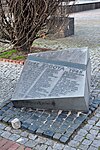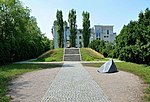Jan Karski Bench (Warsaw)

The Jan Karski Bench (Polish: Ławeczka Jana Karskiego) is a bronze statue in Warsaw, Poland, located at the intersection of Anielewicza and Zamenhofa Streets, next to the POLIN Museum of the History of Polish Jews and the Monument to the Ghetto Heroes. It is located in the neighbourhood of Muranów within the Downtown district. It is dedicated to Jan Karski (1914–2000), a 20th-century soldier, diplomat, and political scientist, who as a member of the Polish resistance, reported to the Western Allies about state of occupied Poland, Germany's destruction of the Warsaw Ghetto and its operation of extermination camps on Polish soil. The monument depicts him sitting on an armchair, leaving additional space for passersby to sit next to him. It was designed by Karol Badyna, and unveiled on 11 June 2013.
Excerpt from the Wikipedia article Jan Karski Bench (Warsaw) (License: CC BY-SA 3.0, Authors, Images).Jan Karski Bench (Warsaw)
Warsaw Midtown
Geographical coordinates (GPS) Address Nearby Places Show on map
Geographical coordinates (GPS)
| Latitude | Longitude |
|---|---|
| N 52.249355555556 ° | E 20.994438888889 ° |
Address
00-187 Warsaw, Midtown
Masovian Voivodeship, Poland
Open on Google Maps











